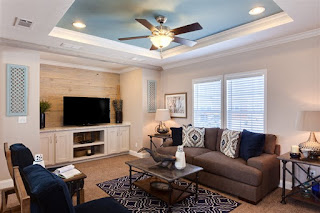Buying your first home in Keller? Congratulations! Now you get the pleasure of decorating and deciding where everything should go in your new residence. But arranging furniture to optimize room layout in a home can be very different from placing furniture in an apartment. You have a lot more to consider than just deciding where to put your sofa or which wall to nestle your bed against.
Here are 4 tips that should point you in the right direction:
Plan the purpose of your room
The design features of your room will heavily influence the arrangement of furnishings and artwork, but you also need to consider how you'll be using the room. Will your living room be where the family gathers to watch TV and movies? A spot for family meetings and conversations with guests? Somewhere you'll go to relax quietly with a good book? All those things or none of them?
Plan your room layout to accommodate the different uses to which you'll put the room. One way to do this is to create zones for different purposes. For example, a sofa and some chairs might face the TV while a small table and wing chair in a corner could be perfect for quiet reading.
Find your focal point
Every room should have a focal point, that spot that automatically draws the eye as soon as you walk into the room. In a living room, this may be a fireplace, picture window or a great view of the interior. The layout of furnishings in the room should flow toward the focal point without blocking it from your view when you enter the room.
If your room doesn't have a focal point incorporated into the design, you can create one in a number of ways. Many people use a large TV as a focal point in living rooms (and that's fine), but you could also paint one wall in an accent color, hang a large eye-catching piece of artwork or use a striking piece of furniture.
Tailor for traffic flow
Modern floor plans tend to be very open in the current market. Even in older homes, where rooms may be more separated from each other, living areas will typically have more than one doorway. It's important to keep ease of movement in mind when you're arranging your furniture.
Avoid blocking natural traffic patterns, such as the line from door to door, or the space between areas like kitchens and breakfast nooks. Never obstruct a door or window by placing a piece of furniture in front of it - unless the piece is short enough that it doesn't block the full window. Generally, straight lines facilitate movement, so imagine straight paths throughout your rooms and place furniture accordingly.
Keep scale in mind
Finally, a word about scale - ensure the size of your furnishings matches the size of your room. A large sectional sofa or king-sized four-poster bed will overpower a small room and leave you little space to move around in. Likewise, too many pieces in a snug space will make the room feel even smaller and cluttered. Conversely, a large, open room can withstand the presence of some larger furnishings, whereas very small pieces will look lost in a big space.
Using these tips can help you plan a layout that fits your lifestyle and enhances your Keller home.
Whether it's selling your home or finding a new one, we have designed this site so that you can quickly and easily locate the information you are looking for. The Grove Team's client-centered approach results in the best possible outcome for you. Please contact us now to begin the process of achieving your dreams in home ownership


No comments:
Post a Comment